The ASUS Zenbook UX305 Review
by Brett Howse on March 25, 2015 8:00 AM ESTGPU Performance
On the GPU side, the Core M-5Y10 has the Intel HD 5300 Gen8 graphics of Broadwell, but with clock speeds of 100 Mhz to 800 Mhz, as compared to the 5Y71 which has 300MHz to 900 MHz available. We have tested several Broadwell processors so far, and the Gen8 graphics are a reasonable boost over the Haswell Gen 7.5 model, with a bump in execution units (EU) from 20 on Haswell to 24 on Broadwell. The Yoga 3 Pro has the Core M 5Y71, which on paper should offer more performance than the 5Y10 based UX305 that we received for review.
One thing that became clear on the Yoga 3 Pro review was how even though the GPU was the same number of EUs as the Broadwell-U processors, and it has the same base and boost clock speed, the 4.5 watt window of Core M limited performance quite a bit. As we saw on the system performance already though, ASUS has elected to allow Core M to get hotter, so that may change the outcome on the GPU as well.
FutureMark 3DMark

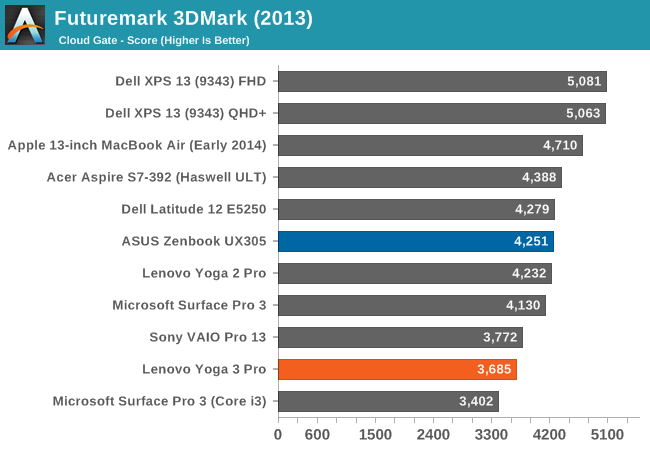
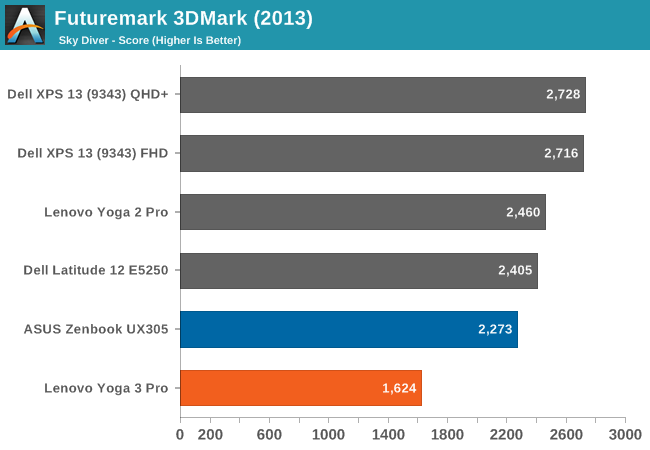

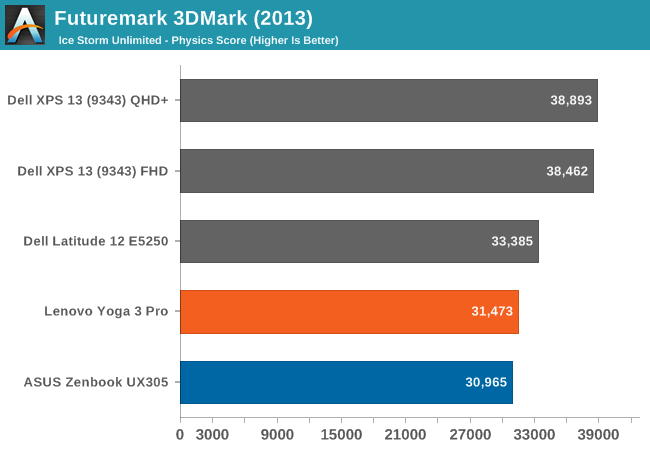
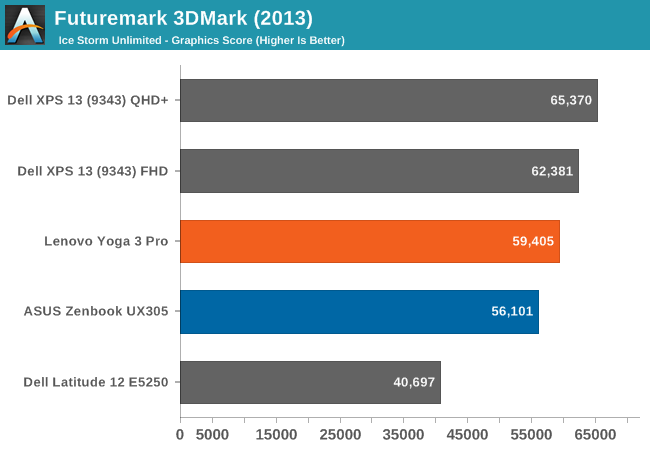
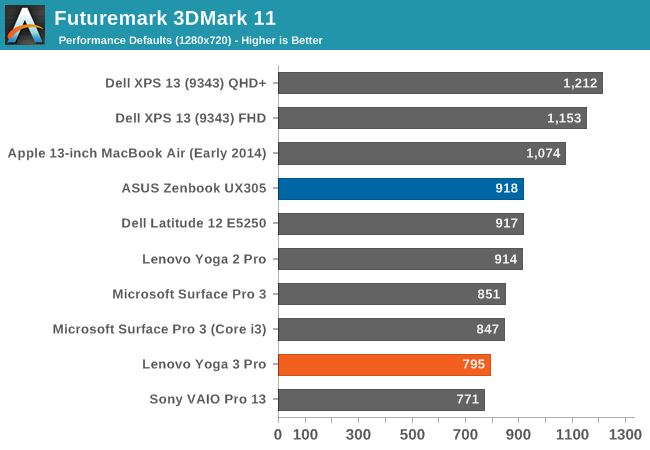
FutureMark has compiled several benchmarks in 3DMark 2013. All are a reasonable length, except for Ice Storm Unlimited which is more of a smartphone/tablet benchmark, and therefore completes very quickly on a PC. Here we can see how much more performance the ASUS UX305 can deliver over the Yoga 3 Pro, which again on paper has a faster processor. ASUS allows much more thermal headroom on the SoC, which results in considerably better scores when using the GPU. The exception to this is the Ice Storm Unlimited, which completes quick enough that the Yoga 3 Pro does not have to throttle as much.
GFXBench
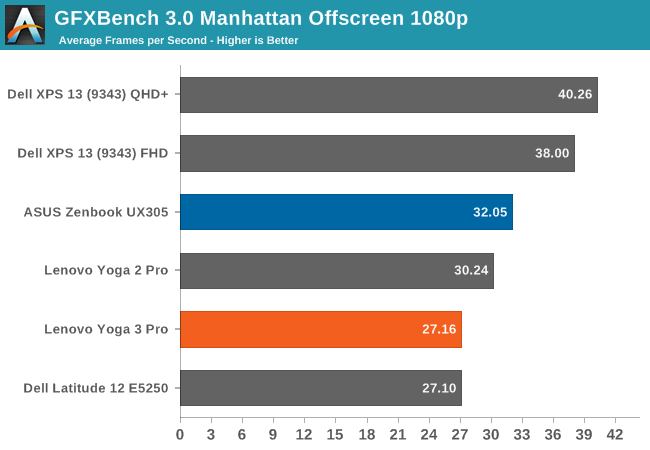
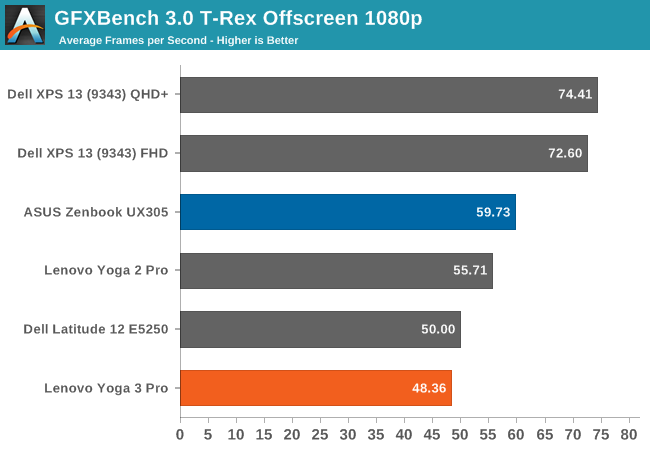
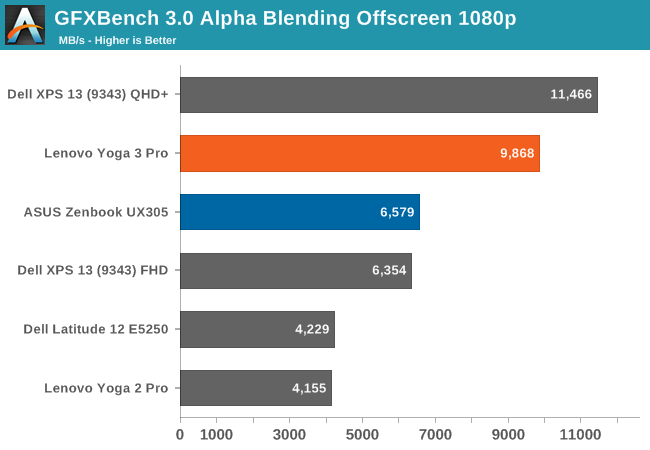
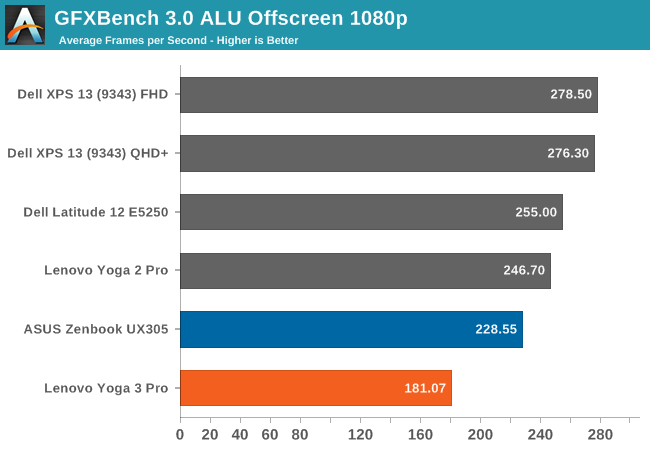
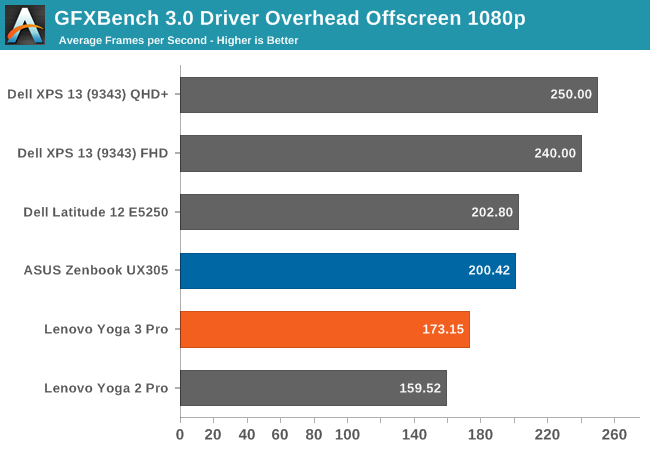
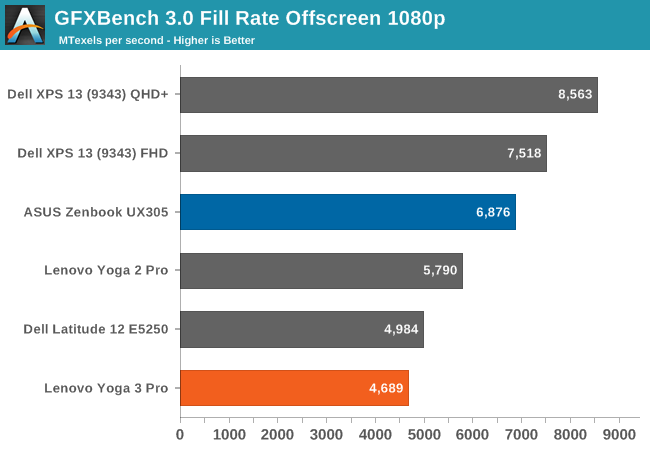
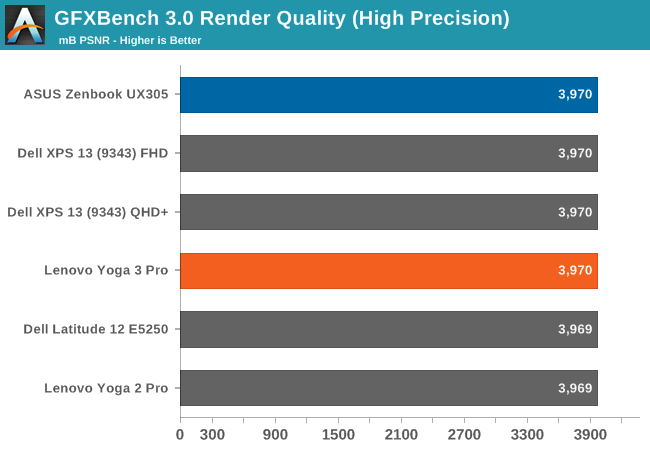
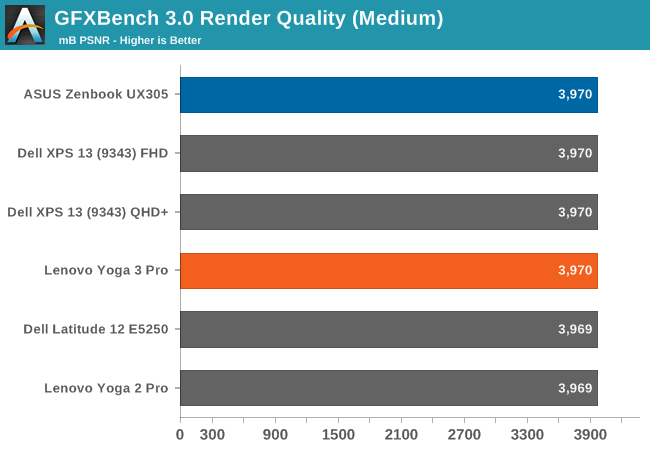
GFXBench 3.0 is available in the Windows Store, and is a DirectX version of GFXBench. On the two gaming benchmarks (Manhattan and T-Rex) we can see that the UX305 pulls ahead of both of the Haswell-U based devices in our graphs, which are the Yoga 2 Pro and the Latitude 12. The Dell XPS 13, with Broadwell-U, is still a lot more powerful which is not surprising since it has a 15 watt TDP compared to just 4.5 watts on Core M (Broadwell-Y). Once again, we can see that the ASUS is stronger than the Yoga 3 Pro.
DOTA 2 Benchmarks
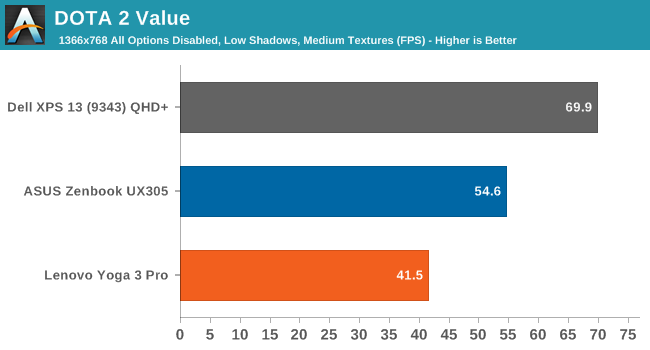
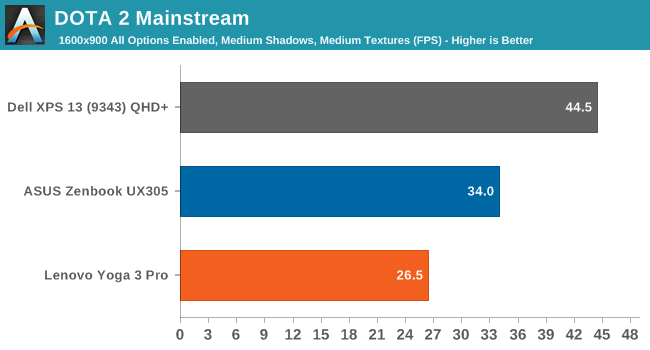
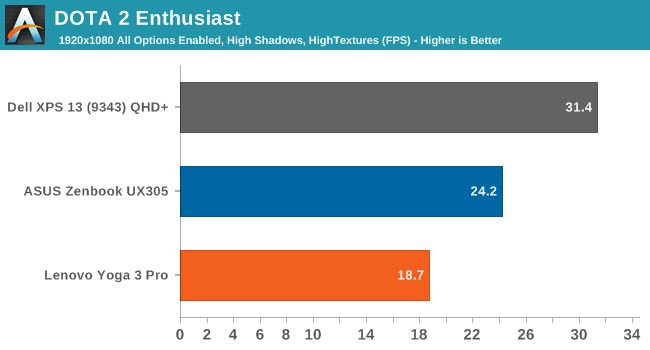
One area where the Yoga 3 Pro struggled was with our DOTA 2 benchmark, which is quite long in duration. We run at three different levels, and the Yoga 3 Pro fell quite far behind the Dell XPS 13. The ASUS UX305 closes that gap though, and gave a much higher frames per second than the Yoga 3 Pro.
Tablet Comparison
As with the Yoga 3 Pro, we will compare the ASUS UX305 to several tablets to see where Core M fits in the lineup. The UX305 is certainly not a tablet competitor unlike the Yoga 3 Pro, but the improved GPU performance seen in the laptop comparisons should give us some more information to about where the Intel graphics compare to the best SoC GPUs available today.
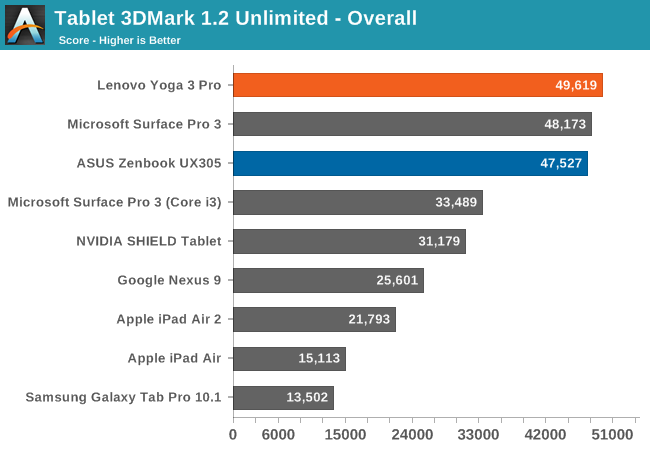
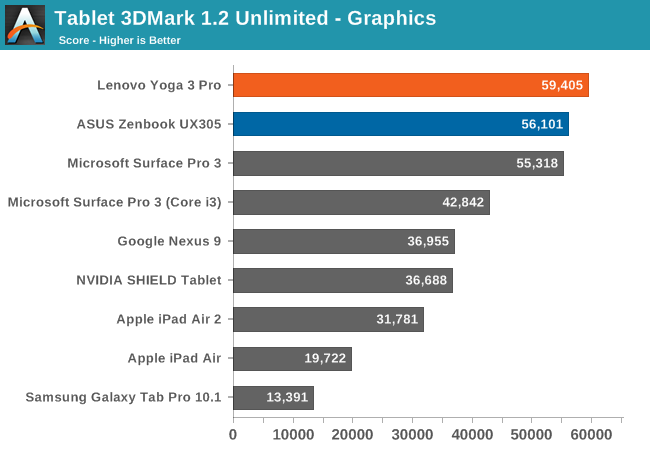

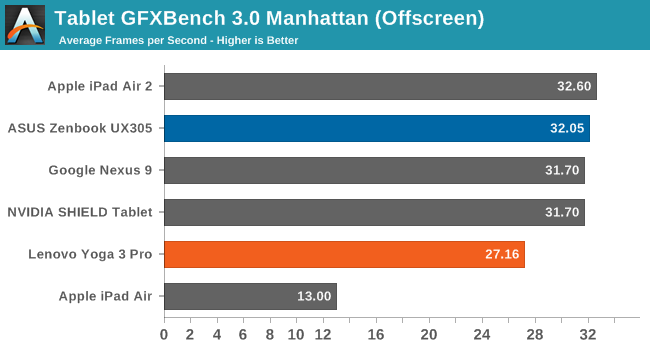
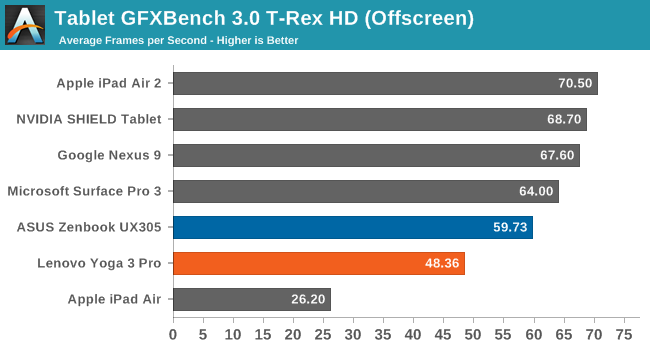


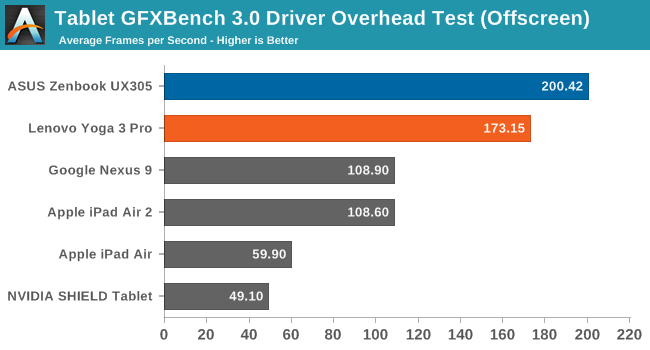
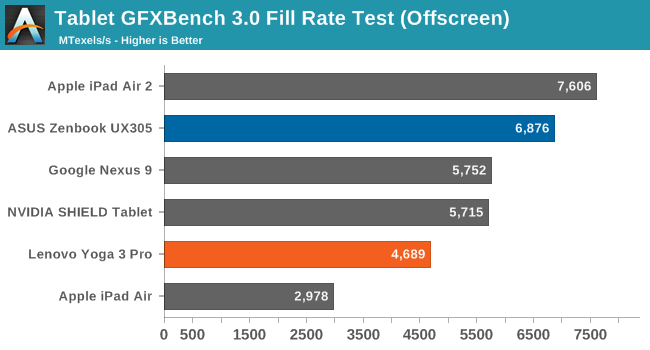
3DMark Unlimited shows the capabilities of the GPU, but is so short that the throttling issues we have observed do not come in to play. The Gen8 graphics of HD 5300 should certainly be able to compete favorably to any of the tablet SoCs if give enough headroom, however that is obviously not the case.
The GFXBench scores show that the Core M 5Y10 can compete with tablets, with it coming in very close to the same scores as all of the latest tablets on the Manhattan score. The T-Rex benchmark is much easier, and it falls behind a bit, but is still a lot quicker than the Yoga 3 Pro.
GPU Conclusion
The increased thermal headroom that ASUS allows on the UX305 has dramatically increased the GPU performance of Core M when compared to the Yoga 3 Pro. The device does get warm though, with it hitting close to 50°C at the top of the laptop, but it does not affect the keyboard or wrist areas. The lack of a fan makes these scores even more surprising, but Lenovo has opted to keep the surface temperatures a lot lower on the Yoga 3 Pro.
There is a lot to be said about Core M performance, and too much to put in this review. We will be doing a deeper dive into the performance of Core M and how it performs in various devices, both actively and passively cooled, as well as compared to Broadwell-U based systems which are a more traditional design. Clearly, there is a lot of factors that affect performance in a device such as this than just the label on the spec sheet.


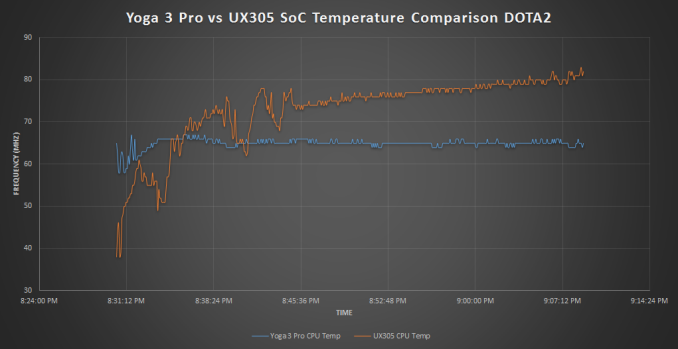








164 Comments
View All Comments
FwFred - Thursday, March 26, 2015 - link
Microsoft store had it for $699. Amazon let's other resellers sell at any price they want, Amazon didn't have it in stick themselves when I checked.dionisk - Tuesday, April 7, 2015 - link
Just bought it 3 days ago from amazon for 699. You just need to keep looking. Amazons prices fluctuate based on their supply.fabrica64 - Friday, March 27, 2015 - link
Too bad it is a 16/9 laptop. Stop 16/9 displays! Why can't people put a 16/10 display... a little bit more of squareness makes a lot of differenceArtShapiro - Friday, March 27, 2015 - link
You're obviously correct, but in (somewhat) fairness, that 1080 pixel vertical resolution is 30 more pixels than an SVGA+ device provides. I like my 1600x1200 Thinkpads, but my 1400x1050 Thinkpads are certainly reasonable.I've never paid much attention to Ultrabooks, but this strikes me as a very intriguing machine, especially for travel. My only Asus device is their now no-longer-produced Mini-TS Windows Home Server box, and it's done fine for quite a few years. What's bothering me is that the more-expensive "Signature" edition is touted as having no bloatware and, curiously, some sort of illy-defined optimization for Windows. That implies that the non-signature edition has some non-optimized Windows settings, whatever that might mean.
Supercell99 - Sunday, March 29, 2015 - link
As someone who recently purchased a ASUS UX303LA Ultrabook, only to find that a design flaw /weakness has rendered it useless, due to the display hinge breaking. I would advise anyone considering an ASUS Ultrabook to look into the hinge/construction on the newer models to see if the have attempted to correct this flaw, in how the thin plastic that attaches the display to the base.Touch screens receive a lot more handling on and by the display in everyday use than non-touch screens and require at least as strong or stronger attachment to the hinge than regular laptops. ASUS neglected to do so with the UX303 series and is resulting in a high failure rate of display/hinges. (see amazon review for example).
Anandtech, while likely beyond the scope of this type of review, please look deeper into the durability and construction of these ultra-portables in the future, as light weight construction techniques , can begin to translate into premature physical/mechanical failures.
eanazag - Monday, March 30, 2015 - link
What is interesting to note is that the Arm tablets' performance results can actually be posted alongside these laptops and not result in flat out jokes. At least in the web results. Convergence in performance is beginning to be real.Allan_Hundeboll - Wednesday, April 1, 2015 - link
I bought the version with 128Gb SSD yesterday. My first impression was disappointment because the 1080p ips screen has alot of light bleed in the bottom. The way this zenbook digs into soft tables is also irritating. But I love everything else about it.SNV - Wednesday, April 1, 2015 - link
Since laptops now are being stripped of any moving parts they should be silent, or so you'd think, but now that there is no humming from the cooling fan or buzzing from the harddrive, and suddenly the sounds from badly designed electronics can no longer hide behind mechanical noise. I propose a new test for electronics like laptops and tablets, the coil wine test. Do a search on "Dell XPS coil whine" (be it XPS 13 or 15 or Precision M3800) and you'll see what all the fuzz or should I say whining is about.A laptop can be fast, light, good looking, have high quality haptics, a battery that will last for days, and no moving parts hence promising no mechanically induced noise, but it can and will probably have some component on the PCB that is screaming IIIIIIIIIHIHIHIHIHIHIHIHIHIHIHIH constantly due to lack of proper EMC shielding of the circuits. The question is will this sound be loud enough to be heard by a user’s ears.
The Dell XPS 13 is winning quite a few tests in this review, but it wouldn't do well in a sound test looking for noise from the electric circuits within the dB(A) range at a distance were a users ears would be.
PhytochromeFr - Thursday, April 2, 2015 - link
Explain is insufficient. intel core's throttling is more complex than that.It's mainly ruled by power usage condition. NOT thermal condition. Intel set 2 turbo power limit for turbo control. short and long. If Processor boost to maximum clock, package power usage reach short limit. core sustains a few seconds maxmum clock until averge power usage in time window reach long limit. after that, core throttles down their clock to until their power usage reach long limit.
Allan_Hundeboll - Tuesday, April 7, 2015 - link
I tested throttling on my ux305 with occp. Idle frequency when running on battery is 800mhz. When plugged in the mains idle freq. is 2ghz.100% CPU load will make the CPU spike @ 2ghz, but quickly settle @ 1.5ghz. 100% CPU and GPU will make the CPU settle @ 700-800MHz. It doesn't get hot so I'm guessing it's because of the power usage.